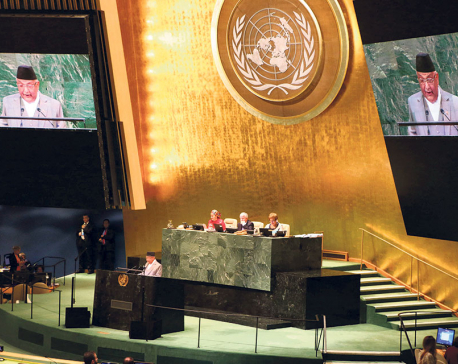
OR
#Climate Finance

More from Author
- Failure is Not an Option for Nepal
- Govt proposes establishment of National Climate Authority to tackle climate change challenges
- Nepal's NIMB Bank receives accreditation from Green Climate Fund for climate action investments
- Empowering Change: Climate Activist Bhatta leads efforts for environmental justice and gender equality
- ‘The global economic system has failed the interest of developing countries’
Nepal's susceptibility to the impacts of climate change underscores the urgent need for decisive action and substantial financial assistance. Despite this pressing need, Nepal's efforts to attract the necessary climate finance have been notably inadequate.
Nepal is highly vulnerable to the impacts of climate change due to its unique topography and geography. However, it has not been able to cope with these impacts, owing to its low capacity to adapt to the changing climate. Climate change disasters have already begun to have a huge impact on Nepal's economy and the livelihoods of its people. The most vulnerable Least Developed Countries (LDCs), such as Nepal, have very limited capacity and face significant poverty conditions, making it difficult for them to address the impacts of climate change on their own. Additionally, they must contend with numerous other development challenges. Nepal is among the most vulnerable countries to climate change, yet it faces significant challenges in adapting due to its low income and poor human development index. As one of the LDCs, Nepal needs additional international funds to implement plans and programs to lower carbon emissions, adapt to the impacts of climate change, and build resilience.
Plethora of policies, but weak implementation
The Government of Nepal (GoN) has various policy, legal, structural, and procedural arrangements for climate change and environmental protection. Accordingly, national policies, strategies, and plans are formulated and implemented in alignment with the Environmental Protection Act and Regulations, the National Climate Change Policy, the National Environmental Policy, and the 15th National Plan, as well as international commitments outlined in the Paris Agreement. In addition, the National Damage and Loss Framework, the Third National Communication, the Long-Term Strategy for Net-Zero Greenhouse Gas Emissions, the Implementation Plan for National Determined Contributions, the National Adaptation Plan, and the Climate Finance Strategy and Action Plan are currently being implemented.
Similarly, various institutional arrangements have been made to mitigate the effects of climate change. Besides a high-level Climate and Environment Council chaired by the Prime Minister, an inter-ministerial climate change coordination committee has been established at the federal level. A provincial climate change coordination committee has been established as well at the provincial level to enhance capacity building and increase public awareness and to coordinate and cooperate properly with various agencies.
The GoN has made a policy commitment to mobilize climate finance received from international financial mechanisms fairly and equitably. The National Climate Change Policy (2019) stipulates that at least 80 percent of the climate finance received from international mechanisms should be used to implement programs at the local level, with administrative costs kept to a minimum. The climate policy has maintained the same ratio of climate finance flows at the local level, while also reaching out to the most vulnerable, following the articulation made under the GoN’s National Adaptation Program of Action (2010) and Climate Change Financing Framework (2017).
Nepal is recognized as a global leader in implementing climate budget tagging within its national budget. Over the last 12 years, Nepal has built domestic budget policies and institutional systems to effectively regulate climate funding. Nepal’s Climate Change Policy has a provision of spending 80 percent of international climate finance at the local level. Most climate projects in Nepal are externally funded. These projects are designed such that major activities are carried out by the central authorities, while very few are executed by the local authorities. Of late, the concept of locally-led climate actions has been emerging globally. This demands the localization of climate actions led by local authorities rather than central government agencies.
However, according to the available data (C & D Dialogue Statement on Budget 2023), for the last fiscal year (2022/2023), two-thirds of the budget was spent by the federal government, with only 22 percent reaching the local governments. Only 9 percent of the climate budget is spent by the provincial governments. It is imperative that the budget should be mobilized at the local level, considering the urgency of localizing climate actions. Also, the majority of Palikas (municipalities) have yet to prioritize climate change in their periodic and annual plans. At the moment, infrastructure development is their priority. This is reflected in the annual budgets prepared by the Palikas; very nominal amount is allocated for climate and disaster risk reduction (DRR).
There has been insufficient research conducted to explore why climate resources are not mobilized at the local level and why they are not fully utilized or absorbed at the national level. Such research/study can be a base for further research to dwell on the issue. Such research can also provide inputs to any other research on climate finance in Nepal. Nepal is among the countries receiving international climate finance, yet accurate records of the amount of climate funding it has received are lacking. A study conducted by Prakriti Resources Centre (PRC), US Dollar 1.92 billion was committed for 609 climate-related projects between 2013 and 2017 to Nepal. Multilateral development banks viz. The World Bank, Asian Development Bank and European Investment Bank are the largest funders followed by the bilateral development agencies like UKAID, USAID and others. The GoNhad submitted a Nationally Determined Contribution (NDC) to the UNFCCC with the target to achieve net-zero emission by 2045. It includes ambitious targets on hydroelectricity and renewable energy generation, electric vehicles and electric cooking, among other targets, to achieve by 2030.
Currently, Nepal's climate finance needs are met by both domestic and international sources, including bilateral and multilateral assistance, as well as funding from dedicated climate finance mechanisms such as the Green Climate Fund (GCF) and the Global Environment Facility (GEF), among others. Various INGOs including ADRA Nepal, Practical Action, People in Need, Oxfam, Mercy Corps, Lutheran World Relief Nepal, Japan International Support Program (JISP) are implanting projects that directly relate to climate change. Also, there are scores of programs being implemented at the local level by various NGOs, bringing money directly from different donors. According to the data provided by MoFE (as of 4 November 2023), there are 26 ongoing climate change related projects and 13 more projects are in the pipeline.
The need
Nepal aims to mobilize USD 33 billion to meet its mitigation targets outlined in the Nationally Determined Contributions (NDCs) by 2030. Additionally, Nepal requires USD 47.4 billion to implement its National Adaptation Plan (NAP) by 2050. The National Adaptation Plan (NAP) has identified 64 projects across nine priority sectors for building climate adaptation. USD 45.9 billion is estimated for the implementation of the identified priority adaptation projects by 2050. The GoN plans to contribute USD 1.5 billion and the remaining USD 45.9 billion is expected to be generated from international finance. A recently unveiled report titled "Response Strategy for Water Resources Management" by Water and Energy Commission Secretariat, estimatesthe need forUSD 52.84 million to address the policy barriers and institutional strengthening to make water management inclusive and climate friendly. Of the total estimated budget under the strategy, 88.5 percent is needed to implement important activities under institutional coordination. This reflects the dire need of institutional coordination and regulatory mechanism to address the climate crisis.
Despite these ambitious targets and essential needs, Nepal facesa cash crunch to work towards adaptation and mitigation of the impacts of climate change. Thus, for Nepal, climate finance has become critical to addressing climate change, both to help reduce carbon emissions and take steps to adapt to its adverse impact.The failure to act decisively is not only jeopardizing Nepal's development aspirations but also undermining global efforts to combat climate change and achieve the Sustainable Development Goals (SDGs). Therefore, concerted efforts are needed to bridge the gap between commitments and actions, ensuring a safer and more sustainable future for Nepal and the planet as a whole.
Low absorption capacity
In climate finance, the low level of absorption capacity of climate projects is another key challenge for Nepal. So far, Nepal’s national priorities and discussions are centered on designing programs and interventions to accelerate international climate finance in Nepal. However, less is talked about how best the climate finance can be absorbed so that the projects are timely completed ensuring the project objectives. As various assessments and anecdotes reflect the very low absorbing capacity of the climate projects in Nepal, there is an urgent need to find the reasons for the poor state of climate project implementation. As the solution lies in the identification of the root cause of the problems, it is imperative to have an honest assessment of the state of climate-related project implementation.
Lack of intergovernmental coordination
The constitution places equally important specific rights and sovereignty in every tier of government–federal, provincial, or local. In this context, the relation between the federal and provincial governments is critical in executing projects and delivering results on the ground. The federal government has the sole rights in bringing external funding. The federal government does not want to shed its power and is reluctant to transfer and decentralize power to the lower levels. There is an inter-ministerial coordination committee on climate change within the MoFE, and a mechanism is in place at the provincial governments as well. At the local level, a disaster focal person is entrusted to oversee and coordinate the climate change-related projects. Yet, lack of coordination among the 3 tiers of government was highlighted by many during the study. It is natural for multifaceted projects to face hurdles and challenges; it has to be timely addressed with a strong coordination mechanism and understanding amongst the stakeholders.
As the major climate funding is done through accredited agencies, the length and breadth of the process are time-consuming. The project preparation phase consumes most of the time, leaving behind the limited duration for implementation in the field. Some project officials have said that the projects are implemented barely for 6 months out of the 12 months project cycle in a year. They cite cumbersome procurement modality and delay in endorsing implementation guidelines by the Ministry of Finance (MoF), as reasons for the project implementation delay. Slowly, and steadily, there is growing realization about the importance of climate change and its consideration in planning. However, given the fast-changing global scenario, and domestic urgency, the government, and all stakeholders need serious reflections on the speedy implementation of climate-related projects.
Issues and gaps
Getting climate finance is a tough battle. The government estimates that it needs billions of dollars by 2030, and until 2050 to meet its NDC goals, adaptation goals, and others. However, there is a high disparity among the target and funding. There are certain technical assistance (TA) projects, where Nepal has to return the money in the lack of meeting the implementation deadlines. Many donor-funded projects are undergoing no-cost extension.
To attract external funding, Nepal needs to explore all avenues and sources for accessing international climate finance for the country to supplement its domestic budget. This can help Nepal take adequate climate actions and implement the commitments made under the Paris Agreement. However, the government must primarily focus on grant-based financing, preferably through the direct access modalities. Low absorption capacity of the climate loan is inevitable to invite more challenges in the future. Given the poor performance of the majority of the climate change-related projects, the utilization of the fund is even harder.
Consequences of Poor Budget Performance are very high. The project delay invites project officials to compromise the cost and ultimately the quality. Also, many years would encounter new ground realities. For example, landslides, floods, and other disasters may alter the priorities of the local people. Against such a backdrop, there is a need for a robust strategy to address poor budget performance. The key factors that continue to contribute to the low budget absorption include; slow initiation of the procurement requisitions, weak procurement planning, weak contract management, weak cash flow management, and slow payment processes.
Recommendations
It is critical that budget exercise that is not guided by an overarching sectoral strategy and policy leads to poor execution. Hence, the outcomes remain unchanged. Climate intervention should not be ad-hoc and designed on political whims; it should rather be based on actual demand and a sectoral plan. Limited target roadmaps and 'quick win’ lead to investment in areas that do not address the root cause of the sector’s underperformance.
At the local level (Palika), there is a strong need for sensitization and capacity building of the Palikas regarding climate issues and strong absorption capacity of the climate projects. Good performing palikas must be rewarded, and more climate finance has to be awarded to them by the federal government and provincial governments. Also, there is a need to work with the National Natural Resources and Fiscal Commission (NNRFC) to adjust and add to climate change criteria while allocating resources to these palikas.
'Locally led climate actions' is not only a buzzword;it's the need of the hour. This acknowledges the importance of the local actors' leadership in climate actions and prioritizes those projects. Given the urgency of the climate crisis, a transformative change in our approach is vital and eminent. Strong government institutions with a one-window mechanism to deal with this issue are demanded by many stakeholders, and even government officials agree to such demands. Shall we go for a Climate Investment Board similar to Nepal Investment Board? Shall we constitute a separate authority on climate change? Shall we need a separate ministry for the purpose? These are the pertinent questions that need to be answered.
As climate change is a cross-cutting subject, there are different areas and themes that are intertwined. A dedicated and permanent institution is the need of the hour. We need authority with the institutional memories, where there would not be frequent changes of staff. Climate change is not just a subject of science;it has become an issue of livelihood, politics, diplomacy, and geopolitics. Nepal should be ready to address these complex issues.
You May Like This

Experts highlight need for intensifying diplomatic endeavors as Nepal's climate finance landscape remains poor
KATHMANDU, Sept 2: Kagbeni, a picturesque village in Mustang district, woke up to the shock of a devastating flash flood... Read More...

India can play key role in Nepal's bid to expand global trade: UN official
KATHMANDU, Feb 17: India can play a key role in Nepal's bid to expand its international trade being a close neighbor of... Read More...

Nepal’s peace process an inspiration for many: PM Oli
KATHMANDU, Sept 29: Prime Minister KP Oli has said that the conflict transformation in Nepal could be an inspiring success story... Read More...










Just In
- Heavy rainfall likely in Bagmati and Sudurpaschim provinces
- Bangladesh protest leaders taken from hospital by police
- Challenges Confronting the New Coalition
- NRB introduces cautiously flexible measures to address ongoing slowdown in various economic sectors
- Forced Covid-19 cremations: is it too late for redemption?
- NRB to provide collateral-free loans to foreign employment seekers
- NEB to publish Grade 12 results next week
- Body handover begins; Relatives remain dissatisfied with insurance, compensation amount








Leave A Comment